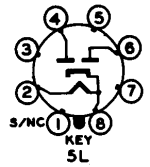DigitalJunkie said:It's to refrence the heaters to ground,and help reduce hum.
Many times a wire wound "Hum Pot" was used instead,with the wiper to ground,you just adjusted the pot untill the hum was gone (or at it's lowest level.)
thank you for the explanation
Craig405 said:I have seen 100 ohm as a standard value for this, going by that i would say 75 ohm would do exactly the same job.
The 2W rating is fine for 6.3V heaters.
Regards
Craig
but for 5V, higher current rating is required?
The two resistors take the place of a center tap on the winding. If the winding has a center tap, ground it and eliminate the resistors.
If there is a 5v winding intended for a tube rectifier, please do not run 100 ohm resistors to ground from it. They will short out your high voltage.
If there is a 5v winding intended for a tube rectifier, please do not run 100 ohm resistors to ground from it. They will short out your high voltage.
Enzo said:The two resistors take the place of a center tap on the winding. If the winding has a center tap, ground it and eliminate the resistors.
If there is a 5v winding intended for a tube rectifier, please do not run 100 ohm resistors to ground from it. They will short out your high voltage.
thanks for the tip. I was planning on grounding the 5v heater to the rectifier :|
Enzo said:
If there is a 5v winding intended for a tube rectifier, please do not run 100 ohm resistors to ground from it. They will short out your high voltage.
what if the 5V line for the rectifier heater has a center-tap? do I ground this wire?
what if the 5V line for the rectifier heater has a center-tap? do I ground this wire?
Most definitely NOT! Shorting of B+ to ground would occur. If you are using a directly heated rectifier, like a 5U4, take the B+ from the CT. OTOH, if you are using a rectifier with a cathode sleeve, like a 5AR4, tie the CT wire off and insulate it THOROUGHLY.
Eli Duttman said:
Most definitely NOT! Shorting of B+ to ground would occur. If you are using a directly heated rectifier, like a 5U4, take the B+ from the CT. OTOH, if you are using a rectifier with a cathode sleeve, like a 5AR4, tie the CT wire off and insulate it THOROUGHLY.
I'll be using a 5V4G which seems to work like a 5U4. so I guess I need to insulate that CT wire then. right?
thanks
I use a 5V4G. Pin 8 is a common heater/cathode connection. I use this as the B+ connection, and it also connects to one side of the heater winding. Pin 2 goes to the other side of the heater winding. There's no centre tap. That is all for those pins, and it gives good performance.
lndm said:I'm sorry if I've missed something here, but are you referring to pin 1?
No, you haven't missed a thing. You and I are on the same page. Pin 8 is THE place to take the B+ from.
Originally posted by jarthel:
I'll be using a 5V4G which seems to work like a 5U4. so I guess I need to insulate that CT wire then. right?
Exactly!
DON"T ground it! You WILL be grounding out your B+. A dead short...


Wayne
Attachments
- Status
- This old topic is closed. If you want to reopen this topic, contact a moderator using the "Report Post" button.
- Home
- Amplifiers
- Tubes / Valves
- resistors across the heater voltage then the middle is grounded
